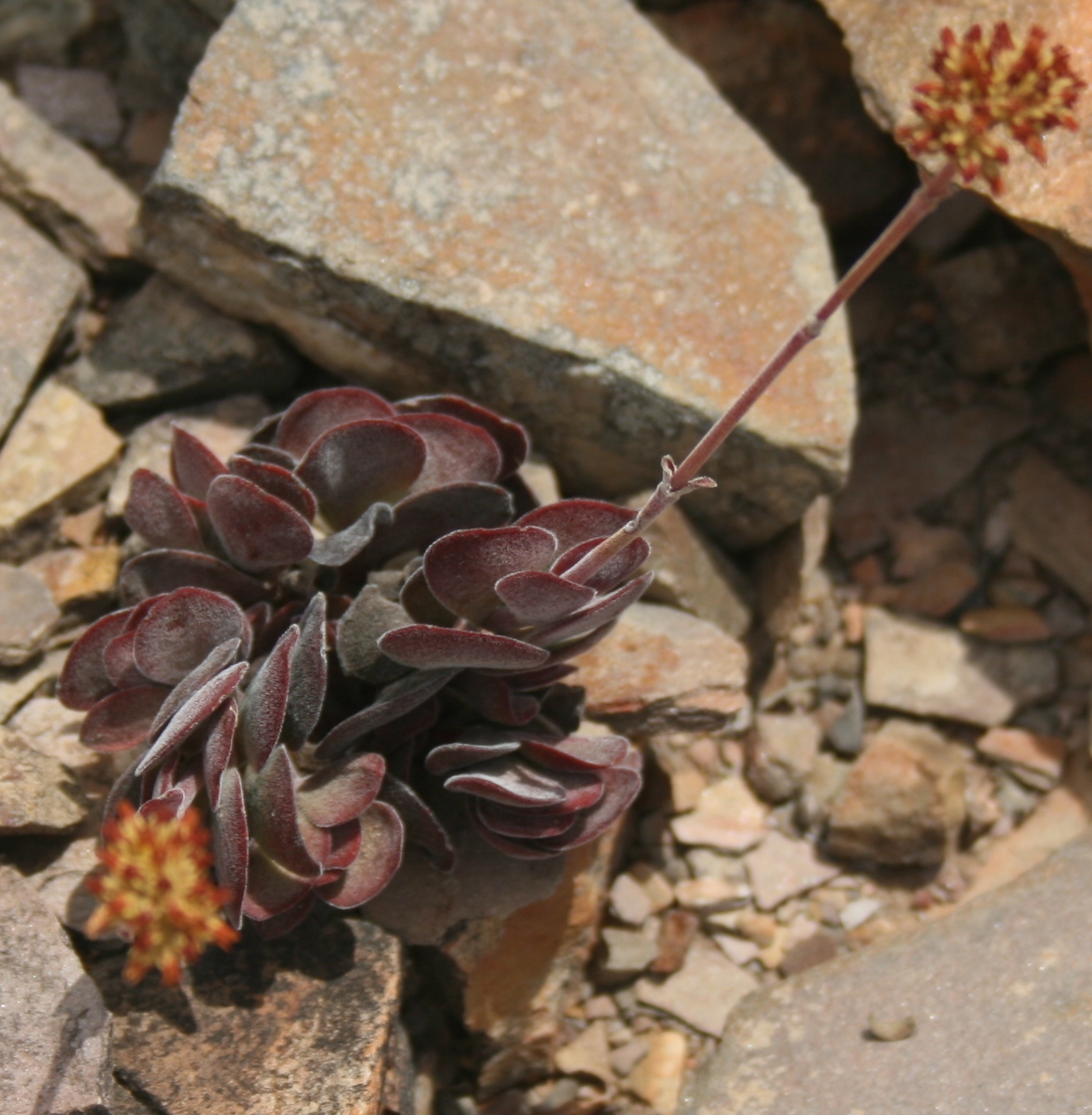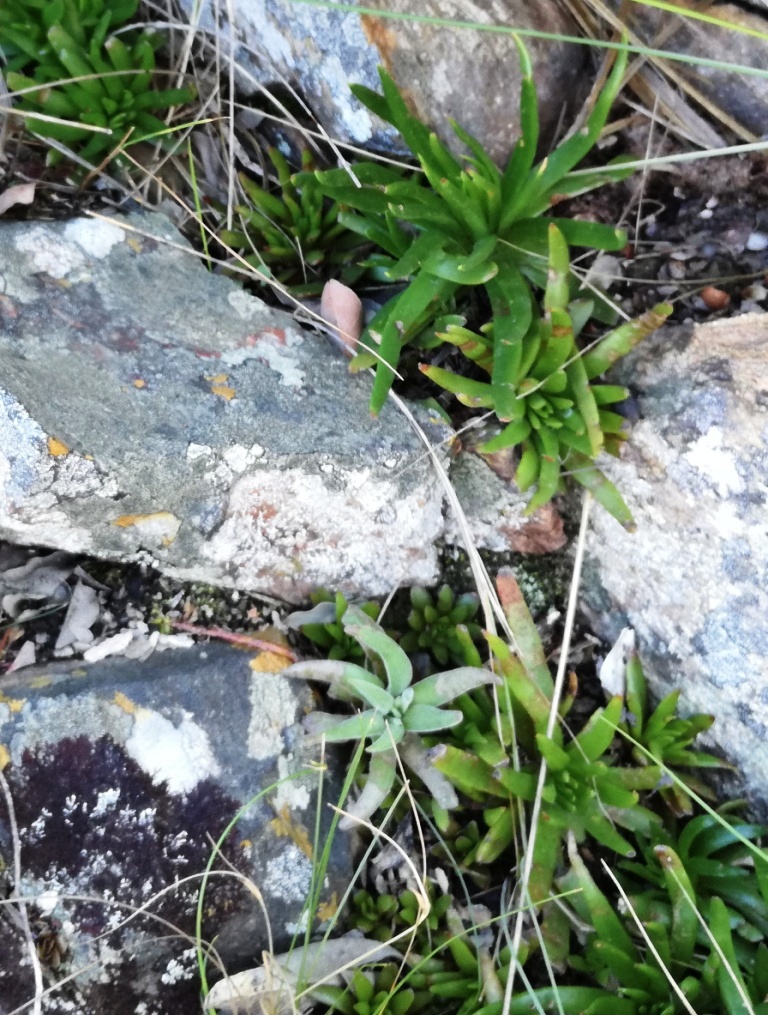|
Crassula Pubescens
''Crassula pubescens'' is a succulent plant, common and widespread in the southern Karoo regions of South Africa. Description A small (up to 40 cm), shrubby perennial, with delicate, erect stems and pubescent (velvety) leaves that are 1-3 cm long. The peduncle emerges above the leaves of the rosette. The peduncle is 3-15 cm long, with one or two bract-pairs (not 15-40 cm long with 2-5 bract pairs like those of ''Crassula subacaulis''). The tips of its 2-3mm long petals are roughly twice as long as they are broad, and have rounded appendages (not beaked/rostrate like those of ''Crassula atropurpurea''). Subspecies This species is variable, and several subspecies exist, which differ in their core features: * sbsp. ''pubescens'': The main subspecies has erect, non-rooting branches that are visible between the pubescent-to-papillate leaves. Its petal appendages are elongated ovally rounded. * sbsp. ''radicans'' (Haw.) Tölk.: This eastern subspecies has smooth leaves and s ... [...More Info...] [...Related Items...] OR: [Wikipedia] [Google] [Baidu] |
Succulent Plant
In botany, succulent plants, also known as succulents, are plants with parts that are thickened, fleshy, and engorged, usually to retain water in arid climates or soil conditions. The word ''succulent'' comes from the Latin word ''sucus'', meaning "juice" or "sap". Succulent plants may store water in various structures, such as leaf, leaves and Plant stem, stems. The water content of some succulent organs can get up to 90–95%, such as ''Glottiphyllum semicyllindricum'' and ''Mesembryanthemum barkleyii''. Some definitions also include roots, thus geophytes that survive unfavorable periods by dying back to underground storage organs may be regarded as succulents. The habitats of these water-preserving plants are often in areas with high temperatures and low rainfall, such as deserts, but succulents may be found even in Alpine climate, alpine ecosystems growing in rocky soil. Succulents are characterized by their ability to thrive on limited water sources, such as mist and dew, ... [...More Info...] [...Related Items...] OR: [Wikipedia] [Google] [Baidu] |
Karoo
The Karoo ( ; from the Afrikaans borrowing of the South Khoekhoe !Orakobab or Khoemana word ''ǃ’Aukarob'' "Hardveld") is a semi-desert natural region of South Africa. No exact definition of what constitutes the Karoo is available, so its extent is also not precisely defined. The Karoo is partly defined by its topography, geology and climate, and above all, its low rainfall, arid air, cloudless skies, and extremes of heat and cold.Potgieter, D.J. & du Plessis, T.C. (1972) ''Standard Encyclopaedia of Southern Africa''. Vol. 6. pp. 306–307. Nasou, Cape Town.''Reader’s Digest Illustrated Guide to Southern Africa''. (5th Ed. 1993). pp. 78–89. Reader’s Digest Association of South Africa Pty. Ltd., Cape Town. The Karoo also hosted a well-preserved ecosystem hundreds of million years ago which is now represented by many fossils. The ǃ’Aukarob formed an almost impenetrable barrier to the interior from Cape Town, and the early adventurers, explorers, hunters, and travelers o ... [...More Info...] [...Related Items...] OR: [Wikipedia] [Google] [Baidu] |
South Africa
South Africa, officially the Republic of South Africa (RSA), is the southernmost country in Africa. It is bounded to the south by of coastline that stretch along the South Atlantic and Indian Oceans; to the north by the neighbouring countries of Namibia, Botswana, and Zimbabwe; and to the east and northeast by Mozambique and Eswatini. It also completely enclaves the country Lesotho. It is the southernmost country on the mainland of the Old World, and the second-most populous country located entirely south of the equator, after Tanzania. South Africa is a biodiversity hotspot, with unique biomes, plant and animal life. With over 60 million people, the country is the world's 24th-most populous nation and covers an area of . South Africa has three capital cities, with the executive, judicial and legislative branches of government based in Pretoria, Bloemfontein, and Cape Town respectively. The largest city is Johannesburg. About 80% of the population are Black South Afri ... [...More Info...] [...Related Items...] OR: [Wikipedia] [Google] [Baidu] |
Crassula Pubescens Var Pubescens - Flowers Detail 3 - Copy
''Crassula'' is a genus of succulent plants containing about 200 accepted species, including the popular jade plant (''Crassula ovata''). They are members of the stonecrop family (Crassulaceae) and are native to many parts of the globe, but cultivated varieties originate almost exclusively from species from the Eastern Cape of South Africa. Crassulas are usually propagated by stem or leaf cuttings. Most cultivated forms will tolerate some small degree of frost, but extremes of cold or heat will cause them to lose foliage and die. Taxonomy ''Crassula'' was first formally described by Carl Linnaeus in 1753 with 10 species. Etymology The name crassula comes from the Latin adjective ''crassus'', meaning thick, referring to the thickening of the succulent leaves. List of selected species *''Crassula alata'' *''Crassula alba'' *''Crassula alpestris'' (Sand-Coated Crassula) *'' Crassula alstonii'' *''Crassula aquatica'' (common pigmyweed, water pygmyweed) *''Crassula arboresce ... [...More Info...] [...Related Items...] OR: [Wikipedia] [Google] [Baidu] |
Crassula Subacaulis
''Crassula'' is a genus of succulent plants containing about 200 accepted species, including the popular jade plant (''Crassula ovata''). They are members of the stonecrop family (Crassulaceae) and are native to many parts of the globe, but cultivated varieties originate almost exclusively from species from the Eastern Cape of South Africa. Crassulas are usually propagated by stem or leaf cuttings. Most cultivated forms will tolerate some small degree of frost, but extremes of cold or heat will cause them to lose foliage and die. Taxonomy ''Crassula'' was first formally described by Carl Linnaeus in 1753 with 10 species. Etymology The name crassula comes from the Latin adjective ''crassus'', meaning thick, referring to the thickening of the succulent leaves. List of selected species *''Crassula alata'' *''Crassula alba'' *''Crassula alpestris'' (Sand-Coated Crassula) *'' Crassula alstonii'' *''Crassula aquatica'' (common pigmyweed, water pygmyweed) *''Crassula arboresce ... [...More Info...] [...Related Items...] OR: [Wikipedia] [Google] [Baidu] |
Crassula Atropurpurea
''Crassula atropurpurea'' (Purple Crassula) is a succulent plant, very common and widespread in the southern Karoo regions of South Africa and Namibia. Description This species is extremely variable. It is typically a small (up to 60 cm), shrubby perennial, with erect, branching stems. Its leaves are erect, or only slightly twisted across the stem. The leaves are sessile and packed evenly along the stems. Each leaf is typically linear-obovate (though this varies greatly), and has a slightly waxy surface. During drought or sun exposure, the leaves can develop a purple colour. Its slender spike-like inflorescence bears pale yellow-white flowers. The key distinguishing character of this species is its roughly canaliculate dorsal petal appendage. Varieties var. ''atropurpurea'' The type variety is the most widespread and variable in appearance. Key features for identifying it include: * The leaf surface is smooth or papillate, but never hairy. * There are 3-4 (rarely 2 or ... [...More Info...] [...Related Items...] OR: [Wikipedia] [Google] [Baidu] |
Crassula Pubescens Var Pubescens - Robertson - Copy
''Crassula'' is a genus of succulent plants containing about 200 accepted species, including the popular jade plant (''Crassula ovata''). They are members of the stonecrop family (Crassulaceae) and are native to many parts of the globe, but cultivated varieties originate almost exclusively from species from the Eastern Cape of South Africa. Crassulas are usually propagated by stem or leaf cuttings. Most cultivated forms will tolerate some small degree of frost, but extremes of cold or heat will cause them to lose foliage and die. Taxonomy ''Crassula'' was first formally described by Carl Linnaeus in 1753 with 10 species. Etymology The name crassula comes from the Latin adjective ''crassus'', meaning thick, referring to the thickening of the succulent leaves. List of selected species *''Crassula alata'' *''Crassula alba'' *''Crassula alpestris'' (Sand-Coated Crassula) *'' Crassula alstonii'' *''Crassula aquatica'' (common pigmyweed, water pygmyweed) *''Crassula arboresce ... [...More Info...] [...Related Items...] OR: [Wikipedia] [Google] [Baidu] |
Crassula Subaphylla
''Crassula subaphylla'' is a succulent plant belonging to the family Crassulaceae. It is widespread in the Karoo regions of South Africa and Namibia. Description A small, sparse, shrubby species. ''Crassula subaphylla'' is a small, dense to sparse, straggly srublet, consisting of numerous brownish stems and branches, 15 — 30 cm tall (up to 60 when scrambling in vegetation). Branches are wiry, woody, but thin and brittle, twiggy (usually decumbent), with flaking strips of bark. Younger branches are slightly velvety (puberulous), reddish-brown, carnose. The leaves are widely dispersed along the branches with internodes of 0.5 — 1 (-3) cm, variable in shape, hairiness and colour (greyish- or reddish-green to yellow-green), distinctively pointed/conical (lanceolate-linear), and easily break off, 5 - 23 mm long and 4 — 8 mm in diameter. It flowers in spring to mid-summer with thyrses up to 8 cm tall with numerous dichasia. The flowers are cream with brown anthers, tubular, p ... [...More Info...] [...Related Items...] OR: [Wikipedia] [Google] [Baidu] |
Crassula Cultrata
''Crassula cultrata'' (Sharp-leaved Crassula) is a succulent plant native to the southern parts of South Africa (the Cape Provinces and KwaZulu-Natal). Description A small, erect, branching shrub (20-80 cm in height) with rounded, yellow-green leaves that have sharp, red-brown, cartilaginous margins. The leaf tip is typically rounded or obtuse. The succulent leaves are flattened, and ob-lanceolate or knife-shaped ("cultrata"). This shape, and the sharp, cartilaginous edges of its leaves, are distinctive. In December/January it produces elongated flower stems (12-40 cm), each with several loosely-held clumps of yellowish flowers (one of which is terminal). Each flower has black anthers and 3,5-4,5 mm long, cream coloured petals. The loose arrangement of the flowers is a key diagnostic character of this species. Relatives This species is related to ''Crassula atropurpurea'', ''Crassula subaphylla'', ''Crassula cotyledonis'', ''Crassula pubescens'' and ''Crassula nudicaul ... [...More Info...] [...Related Items...] OR: [Wikipedia] [Google] [Baidu] |
Crassula Cotyledonis
''Crassula cotyledonis'' is a succulent plant endemic to the arid Namaqualand and Karoo regions of South Africa. Description This plant forms a low, sparse rosette. Its tiny, woody stem is short and against the ground. Its flattened, ovate (sickle/moon-shaped) leaves are usually a light grey-green colour, and can vary from narrowly-ovate (e.g. in the Karoo), to broadly ovate. The greyish leaves are pubescent (velvety) and the fine velvety fur points backward. There is also a line of short hairs along the leaf-margins. The tiny, closed-tubular, globular flowers have 2-3 mm long petals, and are held in rounded bunches along the long, elongated flower-stem (peduncle 8-15 cm). This species is closely related to ''Crassula nudicaulis'', and resembles it in many ways. However, ''C. cotyledonis'' can always be distinguished by the cilia on the margins of the infertile bracts lower on its peduncle, which are not in one single row. The cilia on the margins near the tips of the lea ... [...More Info...] [...Related Items...] OR: [Wikipedia] [Google] [Baidu] |
Crassula Nudicaulis
''Crassula nudicaulis'' is a succulent plant native to South Africa (the Cape Provinces, the Free State, KwaZulu-Natal and the Northern Provinces), and Lesotho. Description ''Crassula nudicaulis'' is a perennial succulent herb with a thickened taproot and several low rosettes of basal leaves. Plants are somewhat variable in appearance and there are several subspecies over the plant's wide range. The leaves of this species can turn brown, but they do not adopt the brick red hues sometimes taken on by ''Crassula subacaulis'' and ''Crassula clavata''. The inflorescence is a spike, with bracts that are not ciliate; the lowest one to three pairs of bracts have no flowers in the axils but the others do. The flowers are turned upwards, they have yellow anthers and distinctive dorsal appendages. This species is closely related to ''Crassula cotyledonis'', which is a more robust species that has marginal leaf-hair in more than one line. It can also be confused with ''Crassula clav ... [...More Info...] [...Related Items...] OR: [Wikipedia] [Google] [Baidu] |





